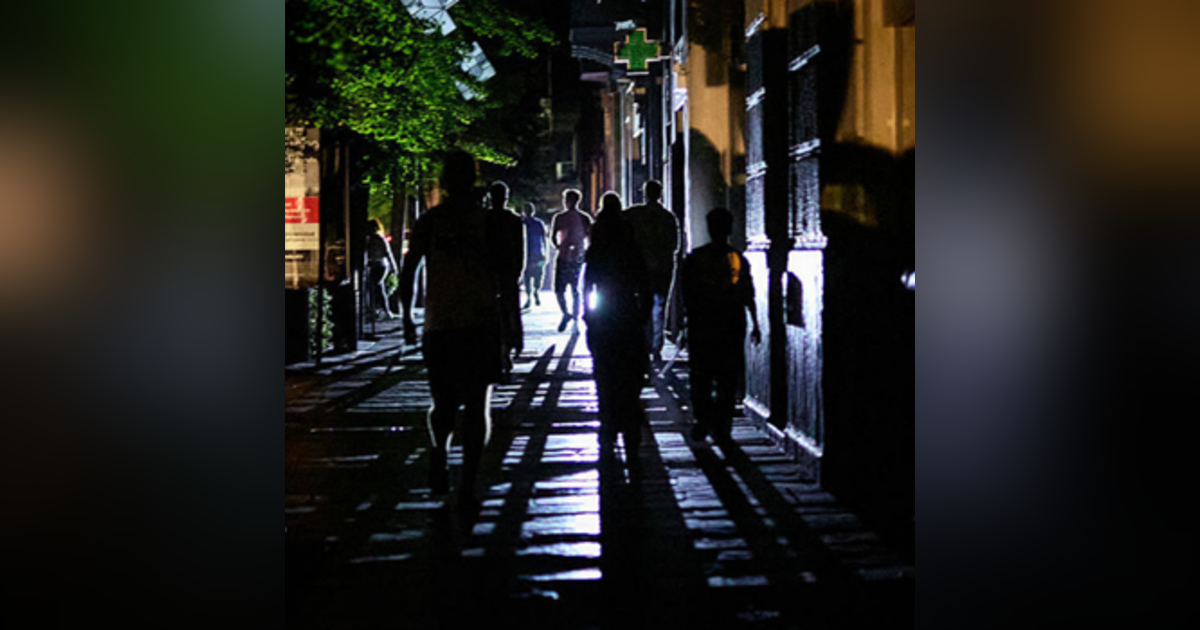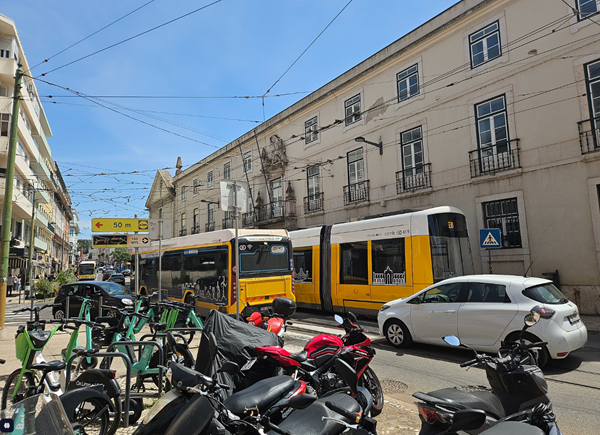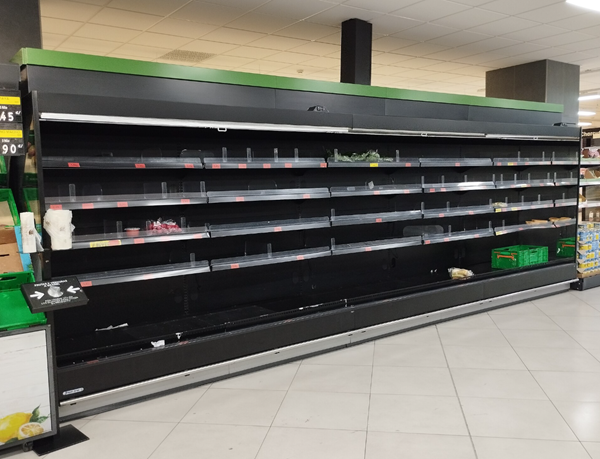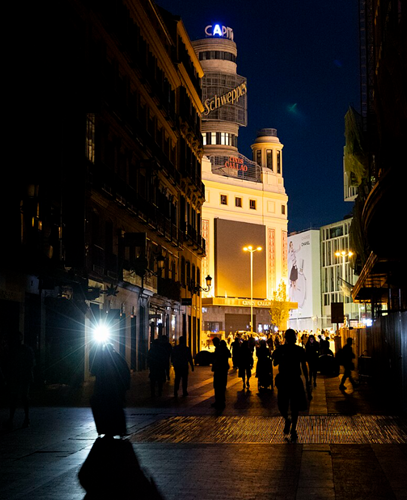European Power Outage: The Zombies Are Coming!

Learn how the April 2025 blackout in Europe was not just a technical failure but a social x-ray. It revealed the fragility of systems we think are unbreakable.
1. Carrington Event [Wikipedia]
2. Massive power outage in Spain and Portugal [APNews]
3. Power Outages and Other Emergencies [Ready Gov]
4. 2025 Iberian Peninsula blackout [Wikipedia]
5. The Iberian Peninsula Blackout — Causes, Consequences [Baker Institute]
Contact That's Life, I Swear
- Visit my website: https://www.thatslifeiswear.com
- Twitter at @RedPhantom
- Bluesky at @rickbarron.bsky.social
- Email us at https://www.thatslifeiswear.com/contact/
Episode Review
- Submit on Apple Podcast
- Submit on That's Life, I Swear website
Other topics?
- Do you have topics of interest you'd like to hear for future podcasts? Please email us
Interviews
- Contact me here https://www.thatslifeiswear.com/contact/, if you wish to be a guest for a interview on a topic of interest
Listen to podcast audios
- Apple https://apple.co/3MAFxhb
- Spotify https://spoti.fi/3xCzww4
- My Website: https://bit.ly/39CE9MB
Other
- Music ...
⏱️ 16 min read
So, this is how it feels at the beginning of the end of the world. No warning. No sirens. Just... darkness.
“On the morning of April 28thof 2025, millions of people across Spain, Portugal, and some areas of southern France watched their lives power down — literally. One flicker, then chaos. Mobile phones dead. Trains stalled. Streets jammed. And for a moment, time stopped.”
“The story today will take you inside the blackout that left an entire region gasping for power — and what it reveals about just how fragile modern civilization really is. I’m talking fragile.
Welcome to That's Life, I Swear. This podcast is about life's happenings in this world that conjure up such words as intriguing, frightening, life-changing, inspiring, and more. I'm Rick Barron your host.
That said, here’s the rest of this story
The Day the Lights Went Out: Spain's Brush with Apocalypse
April 28, 2025, began like any other day across the Iberian Peninsula. People woke up, had their morning coffee, dropped their children at school, and settled into their workplaces. No one could have predicted that by midday, Spain and Portugal would nosedive into what many would later describe as "a glimpse of the apocalypse."
At precisely 12:23 PM, the electricity grid serving over 55 million people went dark. In an instant, modern civilization retreated, exposing the fragile framework upon which contemporary society balances. For nearly twelve hours, Spain's population lived through what experts have long feared: a total systems collapse that brought one of Europe's most developed nations to its knees.
The Descent into Darkness
The initial response from the public was mundane when the power first failed. People assumed localized outages, perhaps maintenance work, or a minor technical glitch. But as minutes stretched into hours, and as mobile phones lost service and internet connections failed, a collective realization cascaded over the population—this was happening, unbelievable as it seemed.
In Madrid, thousands were trapped underground in subway cars, their commutes transformed into claustrophobic ordeals. High-rise buildings became vertical prisons as elevators froze between floors. Hospital staff rushed to activate emergency generators, knowing countless lives hung in the balance. In city centers, traffic lights went dark, turning intersections into chaotic free-for-alls.
Public transportation running on electric power stopped in traffic and remained in operational during the blackout. Courtesy of Wikipedia
"Everyone was suddenly thrust into the same primitive condition," remarked one observer who watched the unfolding scene from a café near a Madrid elementary school. "Some rushed in panic while others sat drinking vermouths on terraces, as if toasting the world's end."
As the hours passed, the population divided into distinct groups: those treating the blackout as an unusual adventure, those calmly but purposefully preparing for worse scenarios, and those gripped by an increasing sense of dread. Parents left their workplaces to collect their children from school. Lines formed deep at bus stops, with overloaded vehicles passing by without stopping. People walked miles to reach their homes, many carrying water bottles and groceries secured with what little cash they had on hand.
The Ticking Clock
Many failed to comprehend how quickly society's collapse might accelerate. Experts in infrastructure security have long warned that modern cities operate on precise timetables of vulnerability once electricity disappears. Ok, so what do I mean by that?
1. Within 6 hours: Communication systems fail as backup batteries deplete. Emergency services become overwhelmed. Food in refrigerators begins to spoil.
2. Within 12 hours: Fuel pumps cease functioning. Hospital generators approach critical fuel levels. Water pressure drops in high-rise buildings as pumping stations fail.
3. Within 24 hours: Medicines requiring refrigeration become compromised. Patients on life support face grave danger. Water supplies in urban centers begin failing. Food distribution halts entirely.
4. Within 48 hours: Sanitation systems collapse. Public health emergencies emerge. Civil order begins to fray as essential resources become scarce.]
5. Within 72 hours: As Dr. Sangeetha Abdu Jyothi of the University of California, Irvine, stated, "Without electricity, we go back to the Stone Age. Especially in high-density urban centers, civilization as we know it would be on the brink."
Spain stood at the precipice of this countdown; the population largely unaware of how close they were to witnessing societal collapse. The blackout would eventually end before reaching these later stages, but the weakness had been exposed.
A Surreal Urban Landscape
As afternoon turned to evening, Spanish cities transformed into other landscapes. Streets typically dominated by the glow of storefronts and the hum of traffic became eerily quiet. People gathered in parks, having nowhere else to go and nothing else to do. Families picnicked with perishable food rescued from warming refrigerators. Some neighborhoods took on an almost festive atmosphere—a collective denial of the growing emergency.
Empty shelves in the fruit section of Mercadona La Vaguada in Cartagena, Spain, as a result of the panic buying triggered by the outage. Courtesy of Wikipedia
In Barcelona, residents of upper floors in apartment buildings discovered they had no water as electric pumps failed. In Seville, hospitals canceled all non-emergency surgeries. The country's gas stations with no functioning pumps could not dispense fuel. Stores without electronic payment systems shuttered their doors, though some accepted cash for essential supplies.
The more prepared citizens filled bathtubs with water while they had the chance. Others scavenged for batteries, candles, and non-perishable foods. Chinese bazaars quickly sold out of portable radios—the only reliable source of information, with telecommunications networks failing. Bottled water vanished from market shelves within hours.
"It was like watching the first act of every disaster film ever made," said one observer who wandered through Madrid's streets. "People were searching for cell signals like ancient diviners looking for water. When someone found a connection, crowds would gather around them, desperate for news."
The national government's response proved woefully inadequate. The Spanish Prime Minister, Pedro Sanchez, appeared on emergency broadcasts nearly five hours after the initial failure, offering nothing more than confirmation that officials had no explanation for the catastrophe. This vacuum of leadership only heightened public anxiety.
The Specter of Something Worse
The blackout raised more terrifying possibilities for those with knowledge of infrastructure vulnerabilities. Was this a cyberattack, perhaps the opening salvo of some larger conflict? Could it be related to the ongoing war in Ukraine? Or might it be even more devastating—a Carrington Event, a massive solar storm that destroys electrical infrastructure worldwide?
The Carrington Event of 1859 had caused telegraph systems to burst into flames across North America and Europe. In today's infinitely more electricity-dependent world, experts from NASA to the Pentagon have warned that a similar solar event could cripple global infrastructure not for hours or days, but for years or even decades.
"It's not a question about whether we will suffer one of these events. It's a question about when it will happen," Holly Gilbert, former director of NASA Goddard's heliophysical science division, has warned.
Spain's blackout offered a brief window into this nightmare scenario. Had the outage continued for days rather than hours, the orderly, even cheerful response might have quickly devolved into something much darker. As one parent noted while grilling sausages before they spoiled, he was already mentally plotting escape routes from Madrid's seven million inhabitants should the crisis extend further.
The Admirable and the Alarming
During the crisis, observers noted two contradictory human responses that emerged simultaneously: remarkable civic cooperation and dangerous complacency.
Throughout Spanish cities, people directed traffic at darkened intersections. Strangers offered assistance to elderly residents of apartment buildings with non-functioning elevators. Families shared resources with neighbors. Surprisingly, the predicted looting and disorder many expected never materialized during the twelve-hour crisis.
Yet alongside this admirable behavior came a troubling innocence about how quickly conditions could deteriorate. Many celebrated the "refreshing" break from digital life, posting later about their delightful "analog day" once power returned. They remained blissfully unaware that hospitals were hours away from crisis, that food supply chains were on the verge of collapse, and that water systems were beginning to fail.
"The world wouldn't begin its final days with zombies invading out of nowhere," reflected one parent who spent the evening with his child, playing games by flashlight while privately calculating how many days of supplies they had on hand. "The zombies would be all of us—wandering without purpose, unaware of how close we stand to the edge."
The Restoration
For most of Spain, electricity returned late that night. It was nearly twelve hours after the initial failure. The restoration came with little explanation. The European Union and Spanish electrical companies denied cyberattack theories. The national power grid company eventually offered a technical explanation involving the sudden loss of 15 gigawatts from solar generation, suggesting critical design flaws in a system increasingly dependent on renewable energy without sufficient battery storage to manage fluctuations.
The economic impact would be measured in billions of euros. Thousands of businesses lost a full day of operations. Food worth millions spoiled in warehouses and restaurants. Countless appointments, surgeries, and services were canceled. Transport systems required hours to resume normal operations.
Yet the true cost might be measured in lost illusions. For twelve hours, Spain experienced what experts have long feared—the extraordinary vulnerability of modern society to infrastructural failure. They had survived what amounted to a dress rehearsal for catastrophe.
What Remains After the Lights Return
In the days following the blackout, Spain steadily returned to normal. People resumed their digital lives. The government promised investigations and improved safeguards. Businesses calculated losses and filed insurance claims.
But something fundamental had changed for those who understood what they had witnessed. They had seen how quickly modern society could unravel; how dependent every aspect of contemporary life had become on uninterrupted electricity. They had glimpsed the razor-thin margin between civilization and its absence.
View from Preciados Street towards Callao Square in Madrid during the blackout, with Preciados still dark while Callao has partial power restored. Courtesy of Wikipedia
Some families quietly began assembling emergency kits. Others investigated solar panels and battery systems for their homes. A few considered relocating from dense urban centers to smaller communities where self-sufficiency might be more feasible.
Most, however, returned to their routines, the lessons unlearned, the warnings unheeded. The national power grid remained vulnerable. Hospital backup systems stayed inadequate. Food distribution chains continued to operate with minimal reserves. And the sun continued its cycles, with another Carrington-level event statistically overdue.
Spain had dodged the bullet—this time. However, the dress rehearsal exposed how utterly unprepared modern society remains for what might come next.
Lessons From the Edge of Catastrophe
Spain's twelve-hour descent into pre-technological existence offers critical insights for populations worldwide:
- The illusion of resilience: Modern infrastructure is remarkably fragile. The complex interdependencies between power, communications, water, food distribution, healthcare, and transportation mean that failure in one system quickly cascades to others.
- The danger of complacency: Many citizens treated the blackout as an inconvenience or even a refreshing break from technology, failing to recognize how quickly actual emergency conditions would develop had it continued.
- The inadequacy of preparation: Neither government agencies nor essential services had sufficient contingency plans for a nationwide blackout. Hospital generator capacity, emergency communications, and public information systems proved insufficient.
- The vulnerability of renewable transition: As nations increasingly shift to renewable energy sources like solar and wind, the lack of adequate storage and grid management systems creates new vulnerabilities that must be addressed.
- The critical importance of community: Throughout the crisis, informal community networks provided more immediate support than official responses. Neighbors helping neighbors proved more effective than waiting for institutional assistance.
What Spain, Portugal and France experienced on April 28, 2025, was ultimately just a warning—a twelve-hour preview of a catastrophe that experts believe remains inevitable on a longer timeline. Whether from solar activity, cyberattack, physical terrorism, or simple technical failure, extended grid collapse represents one of modern civilization's most severe vulnerabilities.
As one observer noted while watching the lights finally come back on across Madrid's skyline: "We got really lucky because nobody was ready for this. Not the companies, not the government, not the people." The question remains whether this brief glimpse into the abyss will motivate meaningful change, or whether the lessons will be forgotten until the next time darkness falls.
That said, the next time, the lights might not come back on so quickly. [1856 words]
What can we learn from this story? What's the takeaway?
The April 2025 blackout was not just a technical failure—it was a social x-ray. It revealed the fragility of systems we assume are unbreakable. It reminded us how unprepared we are, and how quickly life can unravel when the grid goes dark.
Had the blackout lasted another 24 hours, the mood would have shifted. Laughter would have turned to fear. Spain and Portugal would have teetered on the edge of chaos.
If we are to learn anything, it's this: resilience isn't optional. We need better systems, clearer communication, decentralized infrastructure, and a renewed understanding that electricity is not a luxury—it is the lifeblood of modern civilization.
Well, there you go, my friends; that's life, I swear
For further information regarding the material covered in this episode, I invite you to visit my website, which you can find on Apple Podcasts for show notes and the episode transcript.
As always, I thank you for the privilege of you listening and your interest.
Be sure to subscribe here or wherever you get your podcast so you don't miss an episode.
And we'll see you soon.













